| Published: | 2010-07-19 |
| Diameter: | 2.25 inches |
| Length: | 74.00 inches |
| Manufacturer: | U.S. Rockets  |
| Style: | Multi-Stage |
|
Brief: I was intrigued by the kit from U. S. Rockets called a Piston Stager for its looks, but when I realized it had a piston housed in the first stage to give an added boost to the 2nd stage, I became even more interested.
Construction: I made the following modifications to the original kit:
1) Transition section for the 2nd stage attaches by screws (and internal aircraft wood blocks) to the top of the first stage. (I can then inspect or repair the inner piston workings.)
2) Transition section was modified for electronic ignition. It appears that the user is left to his own devices on this matter. I used a 9-volt Nicad battery and a PerfectFlite microtimer. The 9v battery housing caused quite a bulge on the side as shown in Fig. 1.
3) I put vent holes in the outer piston tube, so that the air ahead of the piston diaphragm could vent out.
4) I painted the inside of the piston chamber and diaphragm with barbecue paint.
|
The kit comes with a large variety of quality cardboard tubes and perhaps the kit could be renamed “tubes a-plenty”. The directions call out the parts by dimensions in the step-by-step instructions. So, I simply measured the parts as I went along. I used epoxy for attaching the fins and making fin fillets. The fins are good quality wood I sealed them with Min Max polycryllic, which takes about 4 or 5 steps of filling and sanding. A mylar chute is provided for the first stage. It is good quality for a lighter model and has the shroud lines already attached. I put it aside for another project and attached a larger chute. A wide streamer is provided for the second stage, which looks excellent. Engine mounts are provided for a wide variety of motors from a cluster of 3 D’s to an I-motor. I don’t think I would try an I-motor. I changed the mounts so they can be interchanged using screws as shown Fig. 2.
|
I had trouble placing the 1.1” wood plate into the coupler in Step No. 4, so I ground the bevel with a dremel tool. The transition shroud uses an Ace Fugue Shroud method for producing the tapered transition section. I taped the pattern to the tube as shown in Fig. 3 and then cut the pattern with an Xacto knife. The first cut went well, but then the paper pattern became loose. In hindsight I think a better approach would be to put carbon paper underneath the pattern and trace the pattern onto the tube. For those familiar with this method it produces the angry alligator look shown in Fig. 4. As the build progressed I decided to put in an electronic ignition system in the transition section. This is modification is shown in Fig. 5. On one side I used a PerfectFlite microtimer 3. The hatch for this timer had only a small bulge. I also installed an on/off switch. The hatch for the 9-volt NiCad battery had a large bulge. I led the wires for the second stage through small square brass conduits. I placed the conduits on two of the four seams. These wires were then connected to the second stage Estes igniter by twisting.
Flight: I launched the Piston Stager with a G79-4 in the first stage and a D12-5 in the second stage. I saw the second stage coming down, but I was distracted by other club launches and so I lost the 2nd stage in the Utah sagebrush. From the ground it looks like the timer could have been adjusted to fire the second stage later, because the first stage was continuing to coast up quite a bit. Post-flight inspection indicates that the piston actually worked as designed. The piston was all the way forward in its chamber with a little bit of charring just before the vent holes and the D12 plastic igniter plug was at the bottom of the piston chamber tube. The long sliding piston tube was actually 2 tubes glued together with a coupler. Evidently, I didn't glue the coupler well enough, because the second half of the long piston tube was pulled away and like the second stage I don’t know where it went.
 |
 |
Flights
 |
 |
 |
 |
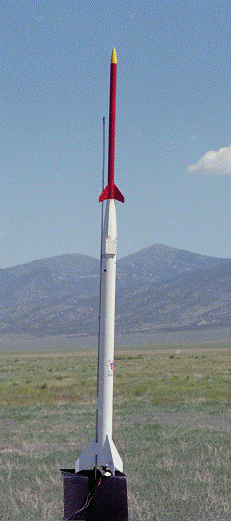
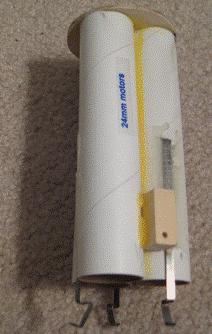
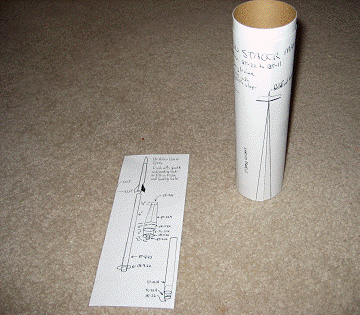
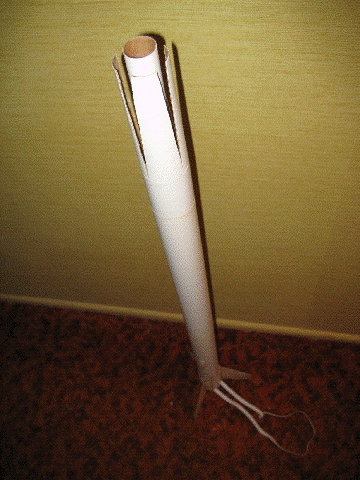
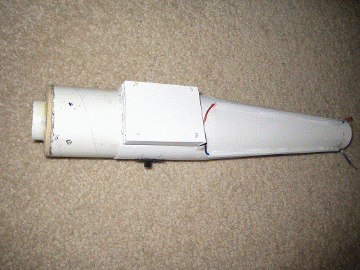
Robert A. Morstadt (September 7, 2020)
I noticed that since I built this model Tim at Apogee has introduced a better way to house the electronic ignition for the second stage. Instead of building an external housing like I did, Tim has conveniently placed an internal compartment for the electronics at the bottom of the piston tube.